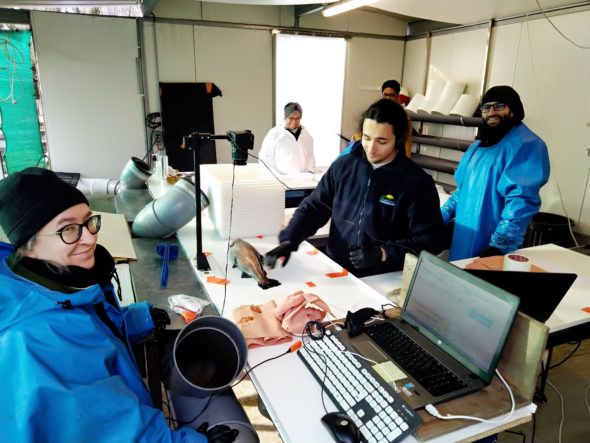Scientists from INRAE (Geneviève Corraze, Sandrine Skiba, Frédéric Terrier & Marc Vandeputte) have been part of the group developing brand new feed for rainbow trout. The aim is to be able to bring a locally produced, more sustainable option to the market.
What is the current state of feed ingredients for rainbow trout?
Historically, fish meal and fish oil have been major ingredients in rainbow trout feeds. Limited availability of those ingredients worldwide (fisheries cannot produce more than they do today), the increase of aquaculture production, and the previous EU-funded research has led to the replacement of fish meal and oil with plant-based proteins and oils, with still a few percent of fish meal and fish oil remaining.

What is the greatest benefit for us in EU?
A key issue is that presently, a large proportion of the plant ingredients are imported to EU and sometimes crops with questionable level of sustainability are used (like soy). Another point that makes feeds still dependent on (mostly imported) fish meal and fish oil is that they are needed to bring the long chain omega-3 fatty acids into the feeds. Omega-3 fatty acids are essential for fish nutrition and welfare as well as for human health.
How did you approach this issue in AquaIMPACT with your trout experiment?
We chose to formulate a fish-free, soy-free feed based on ingredients that could be produced in EU: wheat, potato, corn and yeast proteins, sunflower, rapeseed and linseed oil, as well as microalgae that contain long-chain omega-3 fatty acids. Potato protein, yeast and microalgae are rather novel ingredients, while the others are already widely used.
How the feed was formulated and produced?
This was formulated and produced by the experimental feedmill of INRAE in Donzacq (France), and the product was tested on large rainbow trout (0.5-2 kg) with AquaIMPACT partner company Aqualande, the major trout producer in France. It was compared to the best industry standard feed, produced by Aqualia, the feed company of the Aqualande group.
Any first insights about the experiments?
The INRAE experimental feed performed rather well compared to Aqualia feed giving similar growth (1.71 vs 1.66 kg) but lower feed efficiency (1.23kg feed/kg fish produced for INRAE, 1.04 for Aqualia). The persons in charge at Aqualande said the lower feed efficiency was mostly due to distribution problems of the feed- INRAE feed was sinking and was thus more likely to be wasted, while Aqualia feed was floating.
What is your expectation how the new diets would be acknowledged by consumers in France?
The feed does not contain fish products that are expected to deplete marine fish stocks. We did not use soy, which is mostly imported, may cause deforestation, and is always suspected of being GMO even if most French fish farms use GMO-free soy. Moreover, all ingredients of the novel feed could be produced locally. Thus, we expect that such feeds could satisfy consumers’ expectations. This will be tested in an experimental economy study in 2021.
How would this all increase sustainability?
Aquaculture has to grow further to meet the demand of increased consumption, thus the use of the finite feed resource represented by fish meal and fish oil has to be overcome for sustainability.Expanding aquaculture needs multiple sources of feed raw materials, produced at sustainable costs. This creates also novel branches of supply chain and supports resource efficient circularity in aquaculture. Also, the use of tropical oil and protein crops like soy tend to move the control of environmental impacts outside EU. Using locally produced by-products to produce feed may therefore be also good for sustainability.
